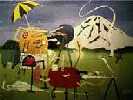
|

Project 2: Modeler - Getting Started |
|
 CSE Home CSE Home |
 CSE 457 CSE 457 |
 Modeler Modeler |
 About Us About Us |
 Search Search |
 Contact Info Contact Info |
|
Getting StartedGet the fixed modeler code here - runs in the CSE undergrad labs!
Files to copy into your project folder in Graphics Lab
The modeler slides from the help session are now available. To get going, you need to download the modeler skeleton code, here,
to retrieve a zipped copy of the skeleton program source code that *will* run in the Allen Center undergraduate labs, but will have the .dll problem in the Graphics lav.
If you are working in the graphics lab, the original code, which works without any changes in the Graphics lab, is
availabe here.
Open
modeler.sln
to build and run the program from within .NET Developer Studio. The code runs
in the graphics lab (Sieg 327). *!!HOWEVER,!!* there is some problem that is
currently not understood that prevents the code from working in the CSE
ndergraduate labs. Whether the code is likely to work for you at home is
entirely unknown. The problem may be less likely to show up with earlier
versions of .NET. If the code works, you should be able to run the code as
is, and a window should appear with a cube sitting on a flat plane. We will be
working on getting a version of the code ready that will run in the labs.
WARNING: We strongly discourage editing the modelerapp and modelerdraw classes. For the Animator project, you will be re-using your new model source file and plugging it into a different application. Thus, if your model library depends on changes or additions you make to the modelerapp or modelerdraw classes, it may not be compatible with the Animator skeleton application. You should be able to implement almost all of the bells and whistles inside your new model source file. Some changes can safely be made to the modelerview class for adding extra camera control functionality; the appropriate source files are documented to indicate where your code should be added. What is a Hierarchical Model?A hierarchical model is a way of grouping together shapes and attributes to form a complex object. Parts of the object are defined in relationship to each other as opposed to their position in some absolute coordinate system. Think of each object as a tree, with nodes decreasing in complexity as you move from root to leaf. Each node can be treated as a single object, so that when you modify a node you end up modifying all its children together. Hierarchical modeling is a very common way to structure 3D scenes and objects, and is found in many other contexts. |
|||||||||||||||
|
Computer Science & Engineering University of Washington Box 352350 Seattle, WA 98195-2350 (206) 543-1695 voice, (206) 543-2969 FAX [comments to ethel] | |